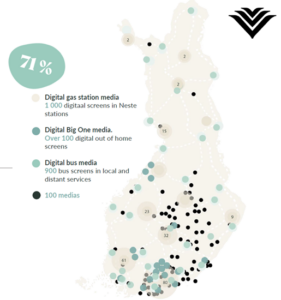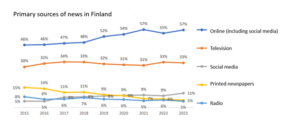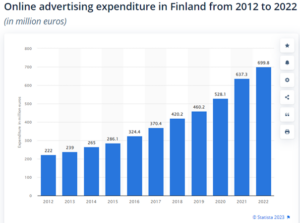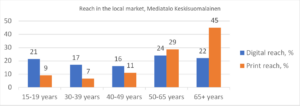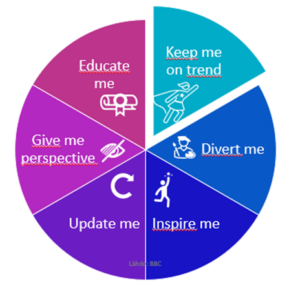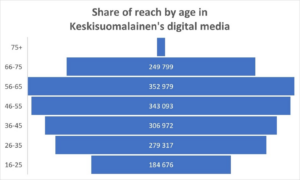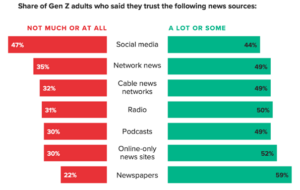Securing the future of Mediakonserni Keskisuomalainen
Abstract: This case addresses the challenges faced by Mediakonserni Keskisuomalainen, a Finnish communications and media corporation, in response to the overall change in consumer buying behaviour and media usage. Additionally, it explores the potential influence of future generations on consumer behaviour. While Mediakonserni Keskisuomalainen currently thrives in the digital arena, the urgency to garner a larger and more loyal readership, particularly among younger demographics, escalates. Competition for this young readership is intense, not just from other media entities but also from various entertainment service providers. The dilemma looms large: How can Mediakonserni Keskisuomalainen preserve its core values while attracting younger audiences without alienating its existing readership? The case focuses on the pivotal transition of converting these digital natives into paying subscribers, a shift that will ensure the company’s financial sustainability in the years to come. Additionally, this shift opens novel commercial opportunities for B2B clients who partner with Mediakonserni Keskisuomalainen to reach a younger demographic. So far, Mediakonserni Keskisuomalainen has been able to receive some good results among the younger audiences, but a bigger leap is yet to be made.
Keywords: newspaper industry, digital transformation, media usage trends, consumer behaviour, digital natives
Authors:
Emmi Tiilikainen, corresponding author, Keskisuomalainen Oyj, Finland, emmi.tiilikainen (at) media.fi
Johannes Niemeläinen, Keskisuomalainen Oyj, Finland
Hanna Karhu, Jamk University of Applied Sciences, Finland
Anne Eskola, Jamk University of Applied Sciences, Finland
Mediakonserni Keskisuomalainen
Mediakonserni Keskisuomalainen is a Finnish communications and media corporation originally located in Central Finland in Jyväskylä. The company’s history began with a single printed newspaper over 150 years ago [1]. Today, the company has more than ninety different media brands nationwide, consisting of both printed newspapers and websites. Financially, the company reported a revenue of 221 million euro in 2022, with an operating profit of 7.4 million euro. Approximately 5,000 individuals work for the company. [2]
The strategy of Mediakonserni Keskisuomalainen acknowledges the challenges it faces and presents solutions for addressing these challenges. It also consists of value-based criteria that are locally national, customer-centric operations, and functions that support locality and are boldly renewable. The company’s core value is responsibility in all its operations. The strategy has notably focused on growth through acquisitions, resulting in a diverse product, brand, and service portfolio. Due to this growth, the company has become a major provider of printed and digital newspapers, digital advertising, research services, marketing and communications services, graphic production, and printing and distribution services.
The company owns five regional companies, which are Kaakon Viestintä Oy, Savon Media Oy, Keski-Suomen Media Oy, Etelä-Suomen Media Oy, and Hämeen Media Oy [3]. All regional companies are independent profit centers, and they have their own sales units (Exhibit 1). All B2B sales units are operating regionally under one brand, which is called Meks. The company also has a separate sales unit for large, nationwide customers. The purpose of Meks is to offer all Mediakonserni Keskisuomalainen’s B2B marketing services and ad solutions under one ceiling-level brand, both locally and nationwide in one place [5].
Mediakonserni Keskisuomalainen operates within the publishing industry. Thus, the company’s most important core ability is to create content that is tempting, committing, and interesting for people, ultimately converting them into loyal readers and subscribers. The other core business, strongly related to the number of loyal readers, is B2B business, which means that the company offers advertising space and solutions in a trusted media and brand-safe environment for its B2B customers. As with most news media companies in Finland, Mediakonserni Keskisuomalainen has a long history in the printed newspaper business, which has been complemented by digital services.
As an organization, Mediakonserni Keskisuomalainen has strong B2B sales units. The company’s B2B customers consist of diverse advertisers. Amongst them, there are small companies with only a few employees but also large chain customers with big advertising budgets. While the needs of these advertisers vary considerably, a shared requirement emerges: the need for media space and advertising solutions to enhance reach and awareness among their respective customer bases. The objective of B2B sales is not only to attract new customers but also to amplify sales volumes relative to current figures. Sales units prioritize establishing enduring customer relationships and hold every client in high regard.
The company has almost one hundred news brands, which fall into five distinct categories: provincial newspapers, regional newspapers, local newspapers, free city newspapers, and magazines. Provincial newspapers and regional newspapers operate analogously. They have full news coverage of local, national, and international stories and they publish a printed edition seven days a week. The difference between provincial and regional newspapers is size: the circulation of provincial newspapers is twice as big compared with regional newspapers. On the web, the number of daily unique visitors varies from 50,000 to 120,000 in the provincial newspapers and from 8,000 to 30,000 in the regional newspapers. [6]
Local newspapers rely heavily on a printed edition published once a week and its corresponding e-paper version. However, in recent years, they have started to invest more in a stronger web presence. Free city newspapers have both a printed version delivered to newsstands across the major cities in Finland and a strong web presence. The largest website of Mediakonserni Keskisuomalainen is Helsingin Uutiset, published in Helsinki, the capital of Finland, with approximately 130,000 daily unique visitors [7]. Every media brand has its own website, and all together, Mediakonserni Keskisuomalainen operates approximately seventy different online media websites. The whole online network of Mediakonserni Keskisuomalainen reaches more than 1.4 million Finns every week. Mediakonserni Keskisuomalainen also publishes magazines directed at professionals working at restaurants and bars. Of customer revenues, the three provincial newspapers bring in approximately 30%, the fifteen regional newspapers 41%, and the local newspapers 29%.
A significant portion of subscribers have a subscription to printed paper. The percentage of digital subscriptions is approximately 20% of the total circulation volume, which means that 80% of the subscription revenue still comes from printed papers. Print subscribers are paying a significantly higher subscription fee (approximately 380 € per year) than digital subscribers (approximately 190 € per year), and they expect to get the same reading experience from the printed paper as they used to. This means that printed papers still demand a lot of resources in terms of printing and distribution.
Digital media business environment
The main competitive advantage of Keskisuomalainen media brands is unique local content, and the editorial strategy and development emphasize this. However, provincial and regional newspapers also offer a large supply of general news; staying competitive in national and international news is part of their editorial strategy. Each city and region has its own strong identity, which is strongly reflected in the local media. Mediakonserni Keskisuomalainen’s media are reporting local, current issues and phenomena more than any other media in Finland, and they address people in their own voice and style. For B2B customers, the locality is also a significant competitive advantage because local companies are willing to reach their readers, that is, potential customers, in local media surrounded by local affairs.
Mediakonserni Keskisuomalainen has major competitors such as Sanoma Media, Alma Media, Clear Channel, and JCDecaux Finland. However, the company’s product and service categories create a steady demand, and the company gives B2B customers the opportunity to get everything with one contact only. Nowadays, Mediakonserni Keskisuomalainen is a market leader in publishing regional and local newspapers. It is also Finland’s largest news and free paper publisher by the number of titles.
Helsingin Sanomat should be identified as the leading Finnish news publisher. It was founded in 1889, is headquartered in Helsinki, and has a strong reputation for providing comprehensive, high-quality journalism. Helsingin Sanomat covers a wide range of national and international news, politics, culture, business, and more, both in print and digital formats. Helsingin Sanomat reaches 2.19 million consumers aged fifteen and above weekly both in digital and print. The combined number of readers of the printed magazine and the e-paper version is 658,900. [8, 9]
The consumption of reading news has undergone a transformation over the past decades. Online news has been increasing its share as the primary source of news, while print newspapers have been losing their share (Exhibit 2). As an example, from an international perspective, the Financial Times, in 2018, had a significant digital readership, with approximately two-thirds of its 900,000 subscribers being digital customers [11]. Subscriptions had also become the primary source of the Financial Times revenue, surpassing advertising, and accounting for roughly two-thirds of the total revenue [10]. It is worth noting that, given the financial constraints on household budgets and the availability of free news, only 17% of people in the world’s wealthiest countries opted for paid online news [12].
Printing processes and technical systems still partly determine what possibilities are available for creating and publishing digital content. According to its strategy, the company must be able to defend the existence and income stream from the printed papers, but at the same time, it must be able to strongly invest in digital platforms and services. Mediakonserni Keskisuomalainen is performing quite well in digital business, but the more time passes, the more important it is to be able to reach new audiences and grow the number of loyal readers, especially in the younger age group of under 30 years old. The company case arises from this need. To stay attractive to B2B customers the company must be better able to attract younger readers, that is Millennials and generation Z.
Online advertising spending in Finland has been steadily increasing over the past decade 2012-2022 (Exhibit 3). The total number of online advertising includes a large variety of different advertising solutions, such as display, instream and outstream video, mobile, native advertising, social media, and search engine marketing. In 2022, 699.8 million euro were spent on digital advertising, which is 52,7 % [14] of the total advertising spent in Finland. From 2021 to 2022, Kantar has published [14] that digital advertising increased by +9,8 %, which is more than the whole media advertising spent growth of +4,1 %.
News media companies offering digital content often use subscriptions to monetize their content online. A paywall ensures that readers cannot get full access to content without paying a subscription fee. This model is among the most used by news media companies and includes several possibilities. The following four are the most common in Finland:
- Hard paywall. Implementing a ‘hard paywall’ strategy typically offers limited access by allowing readers to view a maximum of two free articles. Alternatively, in this model, readers are presented with just the article title and a brief introduction before being prompted to subscribe for full access. This approach is often favored by specialized publications, particularly in the financial sector. However, it is worth noting that the introduction of a hard paywall can come at the cost of potentially losing a sizable portion of the digital audience. It is used by, for example, The Times in the UK. [11]
- Metered paywall. A ‘metered paywall’ is a strategy that grants users the opportunity to read a certain number of articles without charge before encouraging them to subscribe. This model has gained widespread popularity and is employed by numerous newspapers globally. It offers readers a chance to familiarize themselves with the content and presentation style of the media company before considering a subscription purchase. In the case of metered paywalls, determining the appropriate threshold for paid content and understanding the audience’s willingness to pay become crucial to sustaining or expanding the readership. Metered paywall is used by, for example, The New York Times in the US. [11]
- The freemium model allows users to read certain articles for free, but premium articles are behind a hard paywall. This model is used especially by media outlets that hold a dominant position in a certain geographical market. Hence, these newspapers publish articles of general interest or articles that contain crucial information about accidents etc. for free, but their premium content is behind a hard paywall. This model helps newspapers to stay relevant to a wider audience and keep a large enough pool of potential customers while also introducing visitors to the premium content, which they cannot access without a subscription. For freemium models to be successful, determining the right mix of free and paid content is crucial to encourage non-subscribers to visit their sites and to give subscribers the feeling that they get value for their paid subscription. It is used by, for example, Helsingin Sanomat in Finland.
- A hybrid paywall is a mix of the paywall tactics mentioned above, especially a combination of the freemium model and metered paywall. [11]
Mediakonserni Keskisuomalainen has chosen option number three, a freemium model, to attract potential readers. This approach is believed to bring better results in the long term because readers are not able to consume quality content without either engaging in an unbelievably cheap trial period or, after that, hopefully becoming regular subscribers.
Description of the case problem
Now, the company’s greatest challenges are related to the overall change in consumer buying behaviour and media usage, the impact of future generations on consumer behavior, and different regulations and policies regarding privacy and targeting. Older age groups are prevalent in Mediakonserni Keskisuomalainen’s subscriber base. Currently, Mediakonserni Keskisuomalainen is performing quite well in digital business, but the more time passes, the more important it is to be able to reach new audiences and grow the number of loyal readers, especially in the younger age group of 25 to 40 years.
The urgency of this question is highlighted by the fact that in print, the reach in under-30-year-old audiences is approximately 9%, and although the reach of Mediakonserni Keskisuomalainen’s digital outlets is approximately 21% in younger audiences, digital reach has not compensated for the decline in print reach (Exhibit 4). Thus, eventually, the question of reaching younger audiences is existential to Mediakonserni Keskisuomalainen for both B2C and B2B sales.
Although Mediakonserni Keskisuomalainen does not currently know the exact age profile of its customers, there is plenty of research on young audiences done by IRO Research and Tietoykkönen, Mediakonserni Keskisuomalainen’s subsidiaries, and other research companies both nationally and locally. For example, the likelihood of paying for online news is much lower among young audiences than in older age groups, i.e., only 23% of 15–34-year-old respondents consider paying for news extremely or highly likely. The use of social media and chat apps is much more common than that of news media apps. However, all young audiences think that news ought to be consumed and consider news consumption beneficial to them. In the age of disinformation and misinformation, young audiences emphasize the significance of trust when choosing their news sources.
Even if segmenting audiences into age groups is easy, it can produce information about groups that do not exist in the real world. “Young audiences” is a polarized than a homogenous group; hence, any product development process must take this fact into consideration. However, among the already mentioned ones, one thing is common among different young audiences: They are all demanding customers and expect high-quality services, especially if they are willing to pay for them. Also, the needs of young audiences are quite similar in distinct groups, according to BBC [16] (Exhibit 5), who analyzed behavioural data from their services around the world and learned that audiences expect media outlets to fulfill their certain needs.
In the 2010s, Mediakonserni Keskisuomalainen experimented with reaching young audiences in a few separate ways. The most prominent were three blogging portals, two for young female audiences and one for young male audiences, which were initially successful. However, the development of smartphones and visual content made blogging almost redundant, and the commercial logic behind blogging portals eroded. After the blogging portals, there have not been any serious attempts to reach younger audiences.
The company has recognized that it is critical for its business to pull in more of the younger readers and started to create an action plan a few years ago. During the past 1.5 years, this plan has concretized into different projects related to this big goal. One concrete solution to attracting younger audiences is the new mobile application launched at the end of 2023. The application brings a lot of new features for both readers and advertisers, for example, more visual articles and various kinds of rich media ad formats for B2B customers. Rich media formats can be considered any form of digital advertising that includes multiple interactive elements such as video, audio, or some other interactive features. These kinds of ads are designed to encourage user interaction.
However, currently, there is a mutual understanding inside Mediakonserni Keskisuomalainen that reaching young audiences is an existential question. The company’s business is at risk of crumbling eventually if it does not manage to attract and acquire a younger audience. The competition for younger readers is fierce among various media companies and entertainment service providers, and even if there is a strong will to try to reach younger audiences with the current products and new products, Mediakonserni Keskisuomalainen has not been able to produce any viable ideas so far (Exhibit 6). Even if the problem of reaching younger audiences is not explicitly stated in the company strategy, it has strategic value. Mediakonserni Keskisuomalainen needs to offset the predicted decline in print revenues with digital revenues in the 2020s and 2030s. The growth rate of digital revenues must be in double digits throughout the transition period if Mediakonserni Keskisuomalainen is to stay profitable. Profitability is essential for financing the investments needed in the digital transformation. The lion’s share of the company’s consumer sales is in passive subscribers. Thus, the problem is imminent.
Currently, solutions to this problem are searched for in a development group, which has representatives from all three different branches of Mediakonserni Keskisuomalainen’s business: B2C sales, B2B sales, and editorial staff. The group consists of three members of the company’s top management and experts from each of the brands. The composition of the group shows that the problem is taken seriously.
One of the first steps is an online survey, where the company tries to research the needs of its current under-40-year-old audiences. Also, Mediakonserni Keskisuomalainen is enriching its customer records with different parameters, including age. In addition, some of the company’s operational regions have their own customer panels consisting of under-40-year-old customers who are interviewed regularly. However, examining and interviewing existing customers gives only information about those audiences that the company has already reached, not about the audiences the company needs to reach to meet its growth targets.
The biggest part of the company’s advertisers is local SME’s that are familiar with the most traditional formats of advertising, that is, printed ads in newspapers. One way to strengthen the company’s competitive advantage to B2B customers is to be able to provide marketing insight into new target groups, in this case, generation Z. Many B2B customers have the distorted idea that the only way to reach younger audiences and influence them is to advertise on social media. Nevertheless, it is not all about social media. Generation Z might be full of digital natives and heavy users of social media, but they are also more critical as media consumers than baby boomers, and therefore more skeptical about news published on social media.
According to research implemented by Morning Consult [17], even 47% of Gen Z adults said that they do not trust social media platforms much or at all, whereas trust amongst online news sites is at a much higher level. Only 22% of Gen Z adults said that they do not trust newspapers much or at all (Exhibit 7). This insight gives Mediakonserni Keskisuomalainen a good opportunity to encourage SMEs to expand their marketing activities targeted at Gen Z and to traditional media. Besides, the company should also be able to offer tools, marketing solutions, and reasoned views for SME companies and help them create effective marketing campaigns that address younger audiences.
Related to the challenges and goals described above, the company should be able to answer the following questions:
- How and with what solutions can Mediakonserni Keskisuomalainen attract younger readers to consume the company’s content and, at the same time, make sure that the company does not jeopardize the existing business or the basic nature of the news media?
- After attracting younger readers, how to turn them into paying subscribers?
- From the viewpoint of B2B customers, what commercial opportunities could arise if Mediakonserni Keskisuomalainen manages to reach younger audiences?
- What kind of traditional advertising (excluding social media channels) has the strongest effect on the audience under 30 years old (generation Z)?
- What are the key factors advertisers should consider when planning a marketing campaign for this specific customer segment?
- What kind of ad formats and solutions should Mediakonserni Keskisuomalainen create for its new mobile applications so that they would be attractive for B2B customers but also provide commercially significant opportunities for the company?
Exhibits
Exhibit 1. Business area of Mediakonserni Keskisuomalainen in Finland. [4]
Exhibit 2. Primary sources of news in Finland. [10]
Exhibit 3. Online advertising spending in Finland 2012-2022. [13]
Exhibit 4. Mediakonserni Keskisuomalainen’s reach in the local market. [15]
Exhibit 5. BBC study on young audiences. [16]
Exhibit 6. Mediakonserni Keskisuomalainen’s share of reach by age in digital media. [15]
Exhibit 7. Share of Gen Z adults’ trust for different news sources. [17]
Endnotes
[1] Keskisuomalainen (N.d.) Historia. https://keskisuomalainen.com/aikajana/
[2] Keskisuomalainen (N.d.) Taloustieto. https://keskisuomalainen.com/avainluvut/
[3] Keskisuomalainen (N.d.) Alueyhtiöt. https://keskisuomalainen.com/alueyhtiot/
[4] Keskisuomalainen (N.d.) Liiketoiminnat. https://keskisuomalainen.com/liiketoiminnat/
[5] Keskisuomalainen (N.d.) Meks – Tarinasi alkaa täältä. https://meks.fi/meks/
[6] Keskisuomalainen (N.d.) Mediamme tavoittavat 3,1 miljoonaa suomalaista päivittäin. https://keskisuomalainen.com/mediat/
[7] Fiam (N.d.) Media metrics Finland. Daily reach.
[8] Sanoma (2023) Sanoma corporation annual report 2022. https://www.sanoma.com/globalassets/sanoma-group/investors/reports-and-presentations/2023/sanoma_corporation_annual_report_2022.pdf
[9] Sanoma (2023) Sanoman uutis- ja aikakausmediat tavoittavat 91% suomalaisista. https://media.sanoma.fi/ajankohtaista/sanomista-juuri-nyt/sanoman-uutis-ja-aikakausmediat-tavoittavat-91-suomalaisista
[10] Journalismin, viestinnän ja median tutkimuskeskus (2023) Uutismedia verkossa 2023. Reuters-instituutin Digital News Report Suomen maaraportti. https://www.mediaalantutkimussaatio.fi/wp-content/uploads/Reuters_Uutismedia-verkossa-raportti_2023.pdf
[11] KEA (2021). Research for CULT Committee – Europe’s media in the digital decade. European Parliament, Policy Department for Structural and Cohesion Policies, Brussels.
[12] Reuters Institute (2023). Digital news report 2023. https://reutersinstitute.politics.ox.ac.uk/sites/default/files/2023-06/Digital_News_Report_2023.pdf
[13] Statista (N. d.). https://www.statista.com/statistics/545667/digital-advertising-expenditure-in-finland/
[14] Kantar (2023). Mediamainonnan määrä vuonna 2022 päättyi +4,1% kasvuun. https://www.kantar.com/fi/inspiraatioksi/mediamainonnan-maara/vuosi-2022
[15] Mediakonserni Keskisuomalainen Oyj. 2021. Mediamarkkinakatsaus. Internal report: unpublished.
[16] Shiskin, D. (2018). The Future of News, BBC World Service. A presentation at Google News Innovation Forum. https://www.youtube.com/watch?v=9NjLFG1LOhw
[17] Morning Consult (2022). Trust isn’t everything when it comes to Gen Z news consumption. https://morningconsult.com/2022/06/22/gen-z-trust-social-media-news-consumption/.
